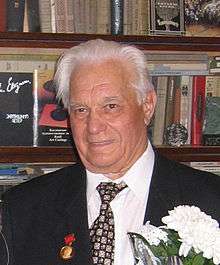Vladimir Teplyakov
| Vladimir A. Teplyakov | |
|---|---|
 | |
| Born | 6 November 1925 |
| Died |
10 December 2009 (aged 84) Protvino, Russia |
| Nationality | Russia |
| Fields | Physics |
| Institutions |
Institute for High Energy Physics Institute of Problems of Chemical Physics |
| Known for |
High energy physics Accelerator physics |
| Notable awards |
Lenin Prize (1988) Order of Lenin Order of the October Revolution Order of Glory 3rd Class Order of the Patriotic War 2nd Class Medal "For Valour" Medal "For the Victory over Germany in the Great Patriotic War 1941–1945" Medal "For the Capture of Vienna" |
Vladimir Aleksandrovich Teplyakov (Russian: Владимир Александрович Тепляков) (November 6, 1925 – December 10, 2009) was a Russian experimental physicist known for his work on particle accelerators. Together with I.M. Kapchinsky, he invented the principle of the radio-frequency quadrupole (RFQ), which revolutionized the acceleration of low-energy charged particle beams.[1]
Biography
V.A. Teplyakov was born in Tambov, Russia. At the age of 17, in January 1943, he was drafted into the Red Army to fight in the Second World War, serving in the 3rd Ukrainian Front. He participated in a number of operations in Right-bank Ukraine, Moldavia and Eastern Europe and was awarded combat orders and medals.[2]
After the war, he graduated from the All-Union Correspondence Polytechnic Institute in Moscow and joined the team of scientists at the Institute of Chemical Physics of the Soviet Academy of Sciences who worked on the large particle accelerator for conversion of uranium-238 into weapons-grade plutonium-239.[3] From 1959 to 1966 he worked at Chelyabinsk-70 to develop a high-current proton linear accelerator for controlled thermonuclear fusion. In mid 60’s, together with G.M. Anisimov, Teplyakov conceived the idea of focusing the charged particle beams by the radio-frequency (RF) accelerating electromagnetic field rather than by solenoid magnets. This work continued at the Institute for High Energy Physics (IHEP) in Protvino, where his group moved in 1966 to build the I-100, a 100 MeV Alvarez drift-tube linac, which was an injector to the U-70, a 70 GeV proton synchrotron, the world's largest particle accelerator at that time.[1][4]
By late 60's, Teplyakov and I.M. Kapchinsky developed the concept of the radio-frequency quadrupole (RFQ) where accelerating gaps are supplemented with spacer electrodes charged under an intermediate potential. Such a focusing system resulted in a noticeable upgrade in performance and a significant decrease of the dimensions of the drift tubes. Teplyakov subsequently developed several RFQ drift-tube structures and RF cavities to drive them.[1][5][6]
V.A. Teplyakov is the author of more than 100 inventions and scientific papers, and is the co-author of the book Linear Accelerators of Ions.[3][7]
Honours and awards
For the invention of the RFQ, Teplyakov was awarded the 1988 Lenin Prize (together with Kapchinsky) and the US Particle Accelerator School Prize for Achievement in Accelerator Physics and Technology.[1][8] In 2006, The European Physical Society awarded him the prize "for outstanding work in the accelerator field".[9]
References
- 1 2 3 4 E H Shibuya (November 2, 2005). "RFQ pioneer celebrates 80th birthday". Cern Courier. Retrieved 2009-12-14.
- ↑ Jan Cherniak; Jane Zavalishina; Elena Kolmanovskaya; Ekaterina Solntseva (2005). "List of Veterans in the Moscow Area". Retrieved 2009-12-14.
- 1 2 "Vladimir Teplyakov" Retrieved on December 12, 2009
- ↑ "Vladimir Aleksandrovich Teplyakov, Translation from Atomnaya Energiya, Vol. 99". November 5, 2005. Retrieved 2009-12-14.
- ↑ Yu. Budanov. "Accelerator Application to Medicine and Technology". Retrieved 2009-12-14.
- ↑ T. M. Kapchinskij; N. V. Lazarev. "The Linear Accelerator Structures with Space-uniform Quadrupole Focusing" (PDF). Retrieved 2009-12-14.
- ↑ D.V. Karetnikov, I.Kh. Slivkov, V.Y. Teplyakov et al. "Линейные ускорители ионов" (Linear Accelerators of Ions). Moscow, Госатомиздат, 1962, 208 pp. (in Russian)
- ↑ "Циклы научных работ, выполненные в ГНЦ ИФВЭ и удостоенные высших государственных премий" (Scientific work made in IHEP and awarded the highest state awards) Retrieved on December 11, 2009
- ↑ "Recipients of EPS-AG Accelerator Prizes" Retrieved on December 12, 2009